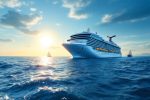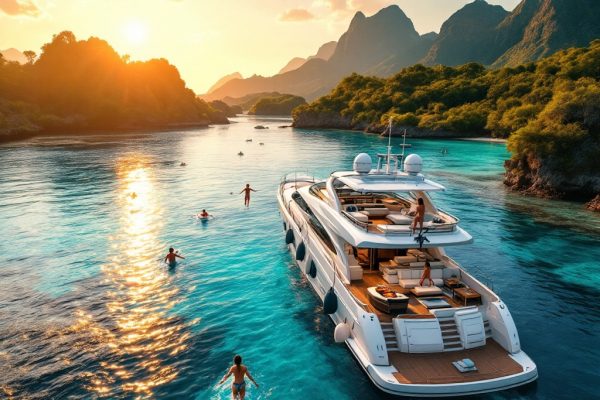Is It Safe to Travel by Sea: How Many Cruise Ships Sink a Year
Dreaming of a luxurious ocean voyage? Modern cruise ships boast advanced safety features like lifeboats, rafts, and fire suppression systems, making cruising statistically safer than driving. Discover how the International Maritime Organization (IMO) regulations and continuous advancements in technology minimize risks, ensuring a secure and enjoyable cruise experience. Learn crucial safety tips and explore the remarkably low probability of major incidents, so you can embark on your dream cruise with confidence. Read on to set sail worry-free!
Important information

- Cruising is statistically a safe mode of transportation due to advanced safety features, regulations, and trained personnel.
- Less than one cruise ship sinks per year. Modern ships have multiple safety systems and follow strict regulations.
- The International Maritime Organization (IMO) sets safety standards for vessels, including design, equipment, and crew training.
- Potential risks include human error, mechanical issues, and severe weather, but the industry actively works to mitigate these through training and technology.
- Passengers can enhance their safety by participating in drills, understanding ship procedures, and staying aware of their surroundings.
Is It Safe to Travel by Sea?
Ocean cruises offer a generally safe travel experience thanks to stringent safety regulations and advanced technology. Modern ships are equipped with numerous safety features, such as lifeboats, rafts, and fire suppression systems. Regular emergency drills are conducted, overseen by trained personnel. While risks like unexpected weather, mechanical problems, and human error exist, statistically, cruising remains a remarkably safe mode of transportation.
Understanding Cruise Ship Safety Features
Cruise ships prioritize passenger safety through various measures, including:
- advanced navigation systems,
- comprehensive lifeboat arrangements,
- rigorous structural integrity protocols.
Standard safety equipment includes:
- lifeboats,
- life rafts,
- fire suppression systems,
- emergency beacons.
Crew members undergo extensive safety training and participate in regular drills. Ships adhere to strict safety regulations, closely monitored by maritime authorities, ensuring a secure voyage for all passengers.
International Maritime Organization (IMO) and Safety Regulations
The International Maritime Organization (IMO), a UN agency, establishes safety standards for all vessels, from massive cruise ships to smaller boats. These regulations encompass ship design and construction, mandating essential equipment like lifeboats, rafts, fire safety systems, and navigation/communication technology. Furthermore, the IMO dictates operational procedures and crew training, including emergency drills, to enhance safety at sea and prevent pollution. This vital organization plays a crucial role in promoting safe maritime travel worldwide.
Passenger Safety on Cruise Ships
Cruise lines prioritize passenger safety through various measures. They conduct regular safety drills and provide comprehensive crew training to mitigate risks and manage emergencies. Advanced safety equipment is standard on board, and the lines adhere to strict international regulations to ensure passenger safety throughout voyages.
Cruise Ship Safety: Risks and Precautions
Cruise lines implement various safety protocols to mitigate potential accidents involving collisions, mechanical issues, fires, or severe weather. Trained crew members are prepared to handle emergencies, including evacuations, fire suppression, and providing medical assistance.For a safe and enjoyable cruise, follow these steps:
Familiarize yourself with the ship’s safety information.
Actively participate in all safety drills.
Be observant of your surroundings.
Locate your assigned assembly station and lifeboat.
Consider travel insurance for additional protection against unforeseen circumstances.
These precautions will help ensure a worry-free voyage.
Common Causes of Cruise Ship Accidents
Several factors contribute to cruise ship accidents. Human error, including crew mistakes and poor judgment, plays a significant role. Mechanical failures, such as equipment malfunctions, are another potential hazard. Severe weather, like storms and hurricanes, poses a considerable threat. Navigation issues can also lead to collisions or groundings. However, the cruise industry continually works to enhance safety by focusing on crew training and implementing advanced technologies to prevent future incidents.
Causes of Cruise Ship Accidents:
- human error, including crew mistakes and poor judgment,
- mechanical failures, such as equipment malfunctions,
- severe weather, like storms and hurricanes,
- navigation issues that can lead to collisions or groundings.
Safety Enhancements in the Cruise Industry:
- continuous work to enhance safety,
- focus on crew training,
- implementation of advanced technologies to prevent future incidents.
Emergency Response Protocols
Passenger safety is paramount in cruise ship emergency protocols. Regular safety drills and clear evacuation procedures are standard practice. Every passenger onboard has a designated lifeboat and life jacket. The crew is expertly trained to guide passengers to safety in any emergency.
Clear communication is vital in emergencies, using advanced technologies for instructions and rescue operations. These systems enable swift and effective responses in critical situations. This commitment to safety ensures passenger well-being during any unforeseen event.
Travel Safety Tips for Passengers
Familiarize yourself with the ship’s safety features, including the location of lifeboats and life vests.
Participating in safety drills is crucial.
Stay informed about weather updates and heed the crew’s instructions; they are there to assist you.
Maintain awareness of your surroundings at all times.
Select reputable cruise lines and always follow safety protocols.
Cruise Ship Safety Record and Statistics
Cruise ship safety is paramount. The industry adheres to stringent rules and undergoes rigorous inspections, resulting in remarkably few fatalities. Ship design, technology, and safety procedures are constantly evolving. International bodies conduct regular ship inspections to ensure compliance with these safety standards. The industry’s focus on continuous improvement includes research, crew training, and the implementation of new technologies to minimize risks. Maintaining these high safety standards is crucial.
Safety Procedures and Regulations
Fatalities on cruise ships are rare, significantly lower than with other forms of travel. Marine casualties, such as groundings and collisions, are also uncommon thanks to strict safety rules and protocols that mitigate risks and prevent major accidents. Thorough investigations are conducted to determine the cause and implement corrective actions when incidents occur. The industry learns from each incident to enhance safety measures.
Low Probability of Fatalities
What are the chances of dying in a cruise ship accident? Statistically, they’re very low. Advanced safety features, comprehensive regulations, and well-trained crews contribute to this strong safety record. While no form of travel is entirely without risk, cruising remains remarkably safe. Passengers can find safety data from reputable sources like maritime organizations and industry associations.
Cruise Ship Safety Inspections and Improvements
Cruise ship safety is constantly improving, thanks to regular inspections ensuring compliance with international regulations. These checks lead to upgrades like enhanced safety features and protocols. This continuous process makes cruising safer and more secure for all passengers.
Fatalities and Marine Casualties
Cruise ship deaths are uncommon. The chance of perishing in a cruise-related incident is incredibly slim—approximately one in 6.25 million. This statistic is negligible.
The Odds of Death in Cruise Accidents
While hundreds of cruise ships sail the seas, accidents, especially sinkings, are rare. Modern ships enhance safety with advanced features and strict regulations, minimizing danger and making cruising statistically safe.
How Many Cruise Ships Sink a Year?
Cruise ship sinkings are rare events, occurring less than once a year. Modern vessels utilize advanced safety technology and adhere to stringent regulations, minimizing the risk. The likelihood of a sinking remains extremely low.
Statistics on Cruise Ship Accidents
Since 2005, 448 major cruise ship accidents have occurred. Sinkings, however, remain infrequent, typically less than one annually. This low sinking rate is attributable to advancements in ship technology and stringent safety protocols.
Instances of Sinking and Their Rarity
Cruise ship sinkings are rare events, demonstrating the industry’s commitment to safety and the many preventative measures in place. In recent decades, these incidents have been infrequent, usually caused by extreme weather conditions or human error. Modern cruise ships are engineered with advanced safety features to enhance their resilience and ability to remain afloat. Some of these features include multiple watertight compartments and sophisticated navigation systems.
What are the Chances of a Modern Cruise Ship Sinking?
Modern cruise ships prioritize safety through advanced technology, stringent regulations, and meticulous maintenance, making sinking extremely rare. While weather events and technical issues can happen, ships have redundant systems and numerous safety features to handle these challenges. Though human error can occur, comprehensive training and robust safety protocols minimize its impact. Less than one cruise ship sinks annually, demonstrating an impressive safety record.
Factors Affecting Sinking Probability
Modern cruise ships prioritize safety and minimize the risk of sinking through compartmentalized sections and double hulls. Advanced navigation systems further enhance safety. However, severe weather, such as storms and rogue waves, remains a potential hazard. Therefore, operational practices, including crew training and strict safety protocols, are essential. While these robustly built vessels rarely sink, human error, mechanical failures, and collisions still pose risks.
The Role of Weather Conditions and Technical Failures
Cruise ship safety is extremely important, especially because of dangers like strong winds and high waves. Storms increase the risk of accidents.
Regular maintenance and careful inspections are very important to reduce these risks.
Technical problems with the ship’s engines, navigation systems, and other equipment can also be dangerous.
Cruise lines must follow safety rules to minimize dangers from bad weather and technical problems. This helps keep everyone onboard safe.
Human Error and Its Impact on Safety
Human error is a major contributing factor to maritime accidents. Thorough training and strict adherence to safety protocols are crucial for mitigating these risks.














